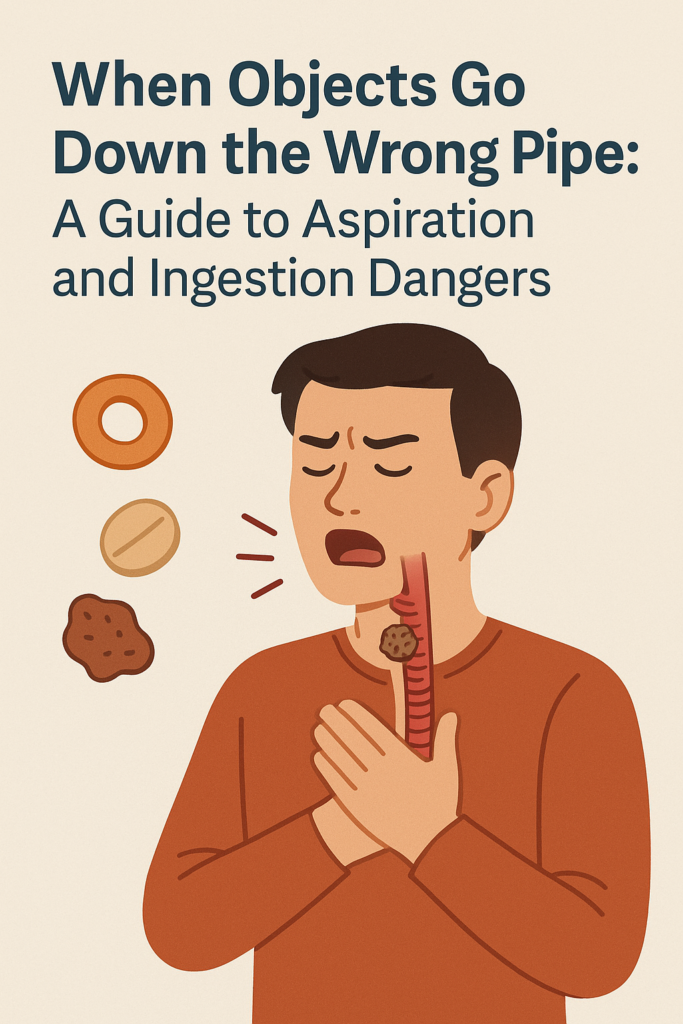Every parent knows that children are curious explorers. From toys and beads to coins and even bits of food, little ones love putting things in their mouths. While this is part of learning, it can sometimes turn risky when an object “goes down the wrong pipe.”
This can mean aspiration (when food or objects accidentally enter the airway or lungs) or ingestion (when something is swallowed into the stomach that shouldn’t be there). Both situations can be stressful for parents and dangerous for children if not handled quickly and correctly.
At CLIO Mother & Child Institute, we see many cases of children coming in with suspected aspiration or ingestion. Here’s what every parent should know.
Aspiration vs. Ingestion: What’s the Difference?
- Aspiration happens when an object, liquid, or piece of food enters the windpipe instead of the food pipe. It can cause choking, coughing, or difficulty breathing.
- Ingestion means the object makes its way into the stomach through the food pipe. Some objects pass through the digestive system naturally, but others—like sharp, large, or toxic items—can cause harm.
Common Items Kids Aspirate or Ingest
Children, especially toddlers between 6 months and 4 years, are at the highest risk. Some of the most common items include:
- Small toys or Lego pieces
- Coins and buttons
- Beads or marbles
- Batteries (especially button batteries – very dangerous!)
- Safety pins, screws, or small household items
- Food items such as nuts, popcorn, grapes, or chunks of raw vegetables
What is Foreign Body Aspiration?
Aspiration occurs when an object inadvertently enters the lungs or windpipe rather than the food pipe. It could be a peanut, a small toy, or even a bead—anything that gets “breathed in” rather than swallowed.
When this occurs, the airway can become partially or completely blocked, which can cause breathing difficulties and even turn life-threatening if not handled promptly.
Signs That Something Went Down the Wrong Pipe
Parents often ask: “How do I know if my child swallowed or aspirated something?”
Here are some red flags:
If the object was aspirated (into the airway):
- Sudden coughing or gagging while eating or playing
- Wheezing or noisy breathing
- Difficulty breathing or shortness of breath
- An indication of oxygen deficiency is bluish lips or skin.
- In severe cases, complete choking with the inability to cry or speak
If the object was ingested (into the stomach):
- Drooling or difficulty swallowing
- Refusal to eat or drink
- Vomiting
- Chest or abdominal pain
Blood in vomit or stools (if the object caused injury)
What Parents Should Do Immediately
If your child is choking:
- If they are still able to breathe or speak, encourage them to let out a cough.
- If not breathing, perform back blows and abdominal thrusts (Heimlich maneuver) depending on the child’s age.
- Call emergency medical services right away.
If your youngster is breathing properly despite having eaten something:
- Do not try to make them vomit.
- Do not eat or drink anything until a doctor advises otherwise.
- Rush to the emergency room, especially if it’s a battery, magnet, sharp object, or large item.
What Not to Do
- Don’t try to pull the object out blindly by putting your fingers in the throat—you might push it deeper.
- Don’t wait and watch if the swallowed item is a button battery, magnet, or sharp object—these require immediate medical attention.
- See a doctor before assuming “it will pass naturally.” Certain items have the potential to inflict silent but dangerous interior harm.
Medical Care: What Happens at the Hospital
At CLIO Mother & Child Institute, our pediatricians and pediatric surgeons carefully assess such cases. Depending on the situation, doctors may:
- Locate the item via endoscopy or X-ray.
- Perform a bronchoscopy if the object is in the airway, to remove it safely.
- Advise observation for small, harmless objects that may pass naturally.
- Provide emergency treatment if breathing is compromised.
Prevention: The Best Approach
Most cases of aspiration or ingestion are preventable. Some safety tips:
- Keep tiny toys, magnets, money, and batteries out of children’s reach..
- Avoid giving whole nuts, popcorn, or hard candies to children under the age of 4.
- Cut food like grapes, carrots, or sausages into small pieces.
- Always supervise young children during mealtime and play.
- Teach older siblings to keep their small toys away from toddlers.
Final Thoughts
Aspiration and ingestion accidents can be frightening, but with quick action and proper medical care, most children recover fully. Early detection of the warning symptoms and prompt assistance are crucial.
At CLIO Mother & Child Institute, we are always ready to support families in emergencies like these, with specialized pediatric care available round the clock.
Your child’s curiosity is a wonderful thing—let’s keep it safe, too.


